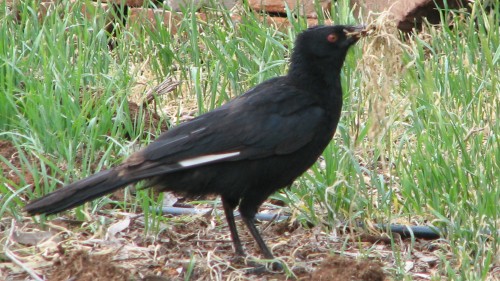Haiku #44 Buzzing honey bees
Buzzing honey bees
Hover around the flowers
Bringing forth sweet dreams.
All rights reserved.
Copyright 2008 Trevor W. Hampel
To read some more of my poems click here.
Haiku #43 White-winged Choughs
Strutting White-winged Choughs
Pick dried grass – moustached mouthfuls
Of mud nest lining.
All rights reserved.
Copyright 2008 Trevor W. Hampel
To read more of my poetry click here.
Writing haiku poetry
Writing haiku poetry has become quite popular in recent decades. Many literary magazines now give significant space to the publication of haiku poetry. Some magazines are entirely devoted to publishing haiku. There is a growing number of websites devoted to this form of poetry.
Haiku poetry is a traditional Japanese form of poetry. It has been popular there for many centuries. In the Japanese form, haiku consist of only three lines. The first line has five ‘sounds’, the second line seven ‘sounds’ and the last line again five ‘sounds.’ The whole poem often makes some reference to nature, and the last line is often reflective in tone.
Haiku written in English are slightly longer, because they are based on syllables rather than the Japanese ‘sounds’. The 5 – 7 – 5 pattern is retained, but this time in syllables. Therefore, the first line has five syllables, the second line seven syllables and the last line five syllables. Again, many haiku are about nature and are reflective in some way.
Here is an example of one I wrote a few days ago:
Persistent begging
Of baby magpies. Gaping
Mouths worm-filled. Silence.
Notice that the poem is untitled. They are usually designated by the first line (or numbered). I usually give mine a title, but only for the purpose of filing on my computer. The first line could do this just as well.
In recent years, haiku writers have departed from the strict 5 – 7 – 5 syllable count. This has been an endeavour to get back to the conciseness of the original Japanese form. It is a very compact, precise and concise form of poetry. That is the beautiful essence of this form of poetry. I usually try to stick to the 5 – 7 – 5 syllable count as I believe it is a good discipline in compact writing. From time to time I do try to use less syllables too.
I understand that there is no plural form of the word haiku.
There is another similar form that has emerged in Australia. It is called Rooku. It looks like a haiku in that it has only three lines. It basically has no other rules except that it must have an Australian theme. Here is an example of one I wrote today:
Sleepy seagulls
Congregate near the boundary.
Cricket ball scatters their dreams.
If you’ve ever attended or watched a cricket match at the Adelaide Oval, you will understand the picture painted by those words.
Read my haiku poems
I invite you to read some of my haiku poems by clicking here. I’d love you to leave comments.
Haiku #42: Raindrops
Raindrops on rooftops
And glistening fresh tree leaves
Are delights of spring.
© 2008 Trevor W. Hampel
All rights reserved.
Haiku #41: Heat
Heat haze shimmering
Over sun dried crisp dead grass.
Shady tree comforts.
© 2008 Trevor W. Hampel
All rights reserved.
